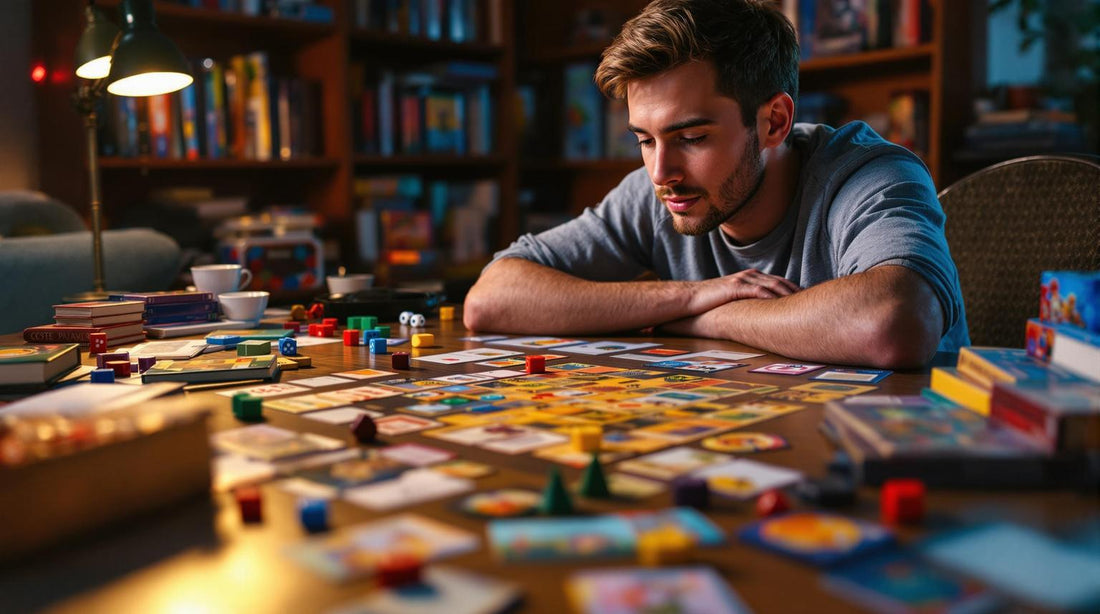Discover the Best Board Games for Every Player

Ultimate Guide to Print-and-Play Solo Games
Print-and-play solo games are a cost-effective and creative way to enjoy tabletop gaming. Here's what you need to know:
- What They Are: Download, print, and assemble your own games using basic materials like paper, dice, and tokens.
- Why They’re Popular: Affordable (often $0–$15), customizable, and ready to play as soon as you print them.
- Game Types: Choose from card games, roll-and-write, adventure games, or puzzles.
- How to Start: Download files, print on quality paper, cut out components, and assemble.
- Beginner-Friendly Options: Try simple, single-page games that are quick to set up.
Pro Tip: Use cardstock for durability and store components in labeled bags or boxes to keep them organized.
Whether you're into strategy, storytelling, or puzzles, print-and-play games let you craft a personalized gaming experience without breaking the bank.
Print-and-Play Solo Games Basics
What Makes Print-and-Play Games Different
Print-and-play (PnP) games take a hands-on approach to tabletop gaming. Unlike store-bought board games that come ready to play, PnP games let you assemble and customize the components yourself. This DIY process gives you the chance to shape the game exactly how you want it.
The main difference is in how you start. With a traditional game, you simply unbox and play. PnP games require some effort upfront for printing and assembly. But this process often deepens your connection to the game - you’ll understand its mechanics better because you’ve put it together yourself.
Main Advantages
Print-and-play solo games bring several perks to the table:
Affordable Fun
Traditional board games can cost $30 to $100 or more. PnP games are much cheaper, often costing between $0 and $15.
Quick Start
After buying a PnP game, you can download the files and start assembling immediately. No waiting for shipping or hunting through stores. You could be playing within hours.
Personalized Components
PnP games let you make choices about how your game looks and feels. For example, you can:
- Pick the paper quality and thickness
- Adjust the size of cards or other pieces
- Print in color or black and white
- Even tweak the rules to fit your style
This level of customization adds a personal touch to your gaming experience.
Common Game Formats
Here are some popular PnP game formats and what they typically include:
| Format | Description | Typical Components |
|---|---|---|
| Card Games | Focused on card-based gameplay | Cards, reference sheets |
| Roll-and-Write | Dice rolls determine actions or scores | Dice, scoring sheets |
| Adventure Games | Story-driven with multiple scenarios | Maps, cards, tokens |
| Puzzle Games | Strategy and logic challenges | Boards, tiles, markers |
Each format offers its own style of gameplay, but all share the same benefits of PnP: affordability, accessibility, and customization. Your choice of format will depend on what kind of games you enjoy and how much effort you’re willing to put into assembly.
Many PnP games also blend multiple formats, creating hybrid experiences that would be difficult or expensive to produce in traditional board games. This flexibility is one of the reasons solo gamers are drawn to the PnP format.
Understanding these basics will help you dive into the world of print-and-play solo games, giving you the tools to create and enjoy your own customized gaming experience.
Finding Solo Games to Print
Where to Get Games
Websites like Brain-Games.lv/en/ provide a mix of free and paid print-and-play solo games with well-designed components. Look for platforms that offer:
- Complete game files with detailed printing instructions
- High-resolution designs
- Rules available in multiple languages
- Regular updates and active community support
Cost Comparison
The price and quality of print-and-play games can vary widely. Here's a quick breakdown:
| Price Range | Features | Component Quality | Support |
|---|---|---|---|
| Free | Basic components, simple rules, black-and-white layouts | Standard resolution, basic cardstock | Community forums |
| $1–5 | Colorful designs, multiple variations, better artwork | High resolution, premium paper options | Email support |
| $6–15 | Professional artwork, expansions, multiple game modes | Print-ready files, special material suggestions | Developer support |
For example, Brain-Games.lv/en/ offers games like Logic Cards: Blue ($4.35), Matchbox Puzzle ($3.85), and a Chess Set with magnetic pieces ($10.99). If you're new to print-and-play games, starting with simpler, lower-cost options is a good way to gain confidence before diving into more advanced games.
Starter Games
For beginners, single-page games with minimal components, straightforward rules, and quick setups are ideal. Brain-Games.lv/en/ has beginner-friendly options like logic puzzles and card games. These games typically require just a few sheets of paper and basic crafting supplies. Puzzle-style games are a great way to get comfortable with assembling print-and-play games.
5 Best Low-Cost Print & Play Solo Games | Easy DIY Board ...
sbb-itb-1ed942f
Printing and Assembly Guide
This guide walks you through the steps to print and assemble your game for a polished and enjoyable play experience.
Materials You'll Need
To create a print-and-play game that looks great and lasts, gather these supplies:
| Basic Materials | Optional Extras | Tools |
|---|---|---|
| Printer paper (65–110 lb) | Cardstock (120+ lb) | Scissors or craft knife |
| Clear sleeve protectors | Laminating sheets | Metal ruler |
| White glue or glue stick | Spray adhesive | Cutting mat |
| Card sleeves | Magnetic sheets | Corner rounder |
| Storage boxes | Premium cardstock | Self-healing mat |
Steps to Assemble Your Game
-
Prepare for Printing
Set your printer to its highest quality setting. Use cardstock for cards and standard paper for rulebooks. Print a test page to ensure everything looks right before printing the full set. -
Assemble Game Components
- For cards and tokens: Print on heavy cardstock for durability. Cut carefully along the provided guidelines. Apply adhesive evenly, press the pieces under a heavy book for 4–6 hours, and store them in sleeves for protection.
-
Assemble the Game Board
- For boards: Print across multiple pages, using registration marks to align them. Apply a thin, even layer of spray adhesive to mount the printout onto foam core for added sturdiness. Once dry, trim the edges neatly.
Storing Your Game
Proper storage is key to keeping your game in great condition for future use.
Short-Term Storage Tips
- Use deck boxes to keep cards organized.
- Store boards flat to prevent warping.
- Separate tokens and pieces into labeled zip-lock bags.
- Avoid exposing materials to direct sunlight or high humidity.
Long-Term Protection Tips
- Store your game in a climate-controlled space (65–75°F).
- Add silica gel packets to containers to manage moisture.
- Clearly label all boxes and bags for easy identification.
- Use sheet protectors to safeguard rulebooks.
Consider using divided storage containers to keep components organized and save space.
Improving Game Quality
Once your game is put together, consider these upgrades to make it more durable and enjoyable to play.
Extra Game Pieces
Swap out basic materials for sturdier options. For example, replace paper tokens with wooden or plastic ones, and upgrade standard dice to custom sets. These changes not only make the game feel better in hand but also ensure the pieces last longer.
Extending Game Lifespan
Protect cards and tokens that are frequently handled by applying thermal lamination. Start by printing on high-quality cardstock, then laminate for a finish that can stand up to repeated use. This simple step can significantly reduce wear and tear over time.
Best Solo Games to Print
Once you've got the hang of printing and assembling games, picking the right one can make your solo gaming sessions even more enjoyable.
Games for Beginners
If you're just starting out with print-and-play solo games, go for ones that have simple rules and require only a few components. These are easier to set up and play, giving you a solid foundation before diving into more intricate games.
Types of Games
Solo print-and-play games come in all kinds of styles. Some focus on strategy and careful decision-making, while others are all about fast-paced action. Whether you prefer solving puzzles, navigating tactical challenges, or playing quick rounds, there’s something out there to match your preferences and schedule.
Brain Games Picks
At Brain Games, we’ve created print-and-play versions of our award-winning tabletop games. These compact editions highlight the core mechanics of the originals, giving you a chance to try them out before committing to the full versions. Check out our exclusive collection at Brain-Games.com.
Getting Started
Ready to dive into print-and-play solo gaming? Here's how to begin assembling your games and start playing in no time.
First, gather the basics: a dependable printer, standard printer paper, cardstock, scissors, and a good glue stick. These will cover everything you need to get started.
For beginners, try single-page games with simple components like cards or tokens. These typically take just 15–20 minutes to print and assemble.
Pro Tip: Run a draft page through your printer first. This helps check color accuracy and can save you some ink.
Here’s a quick guide to assembling your first game:
- Step 1: Download the game files from Brain-Games.com's print-and-play section.
- Step 2: Print the components using the right paper - regular paper for rulebooks and cardstock for cards or tokens.
- Step 3: Cut out the pieces carefully along the marked lines.
- Step 4: Follow the included instructions to assemble everything.
Start with just one game to get the hang of it. Focusing on one project lets you refine your techniques and avoid mistakes.
Once assembled, store your games in labeled bags or small boxes to keep everything organized. As you gain confidence, you can move on to assembling more detailed and challenging games.






